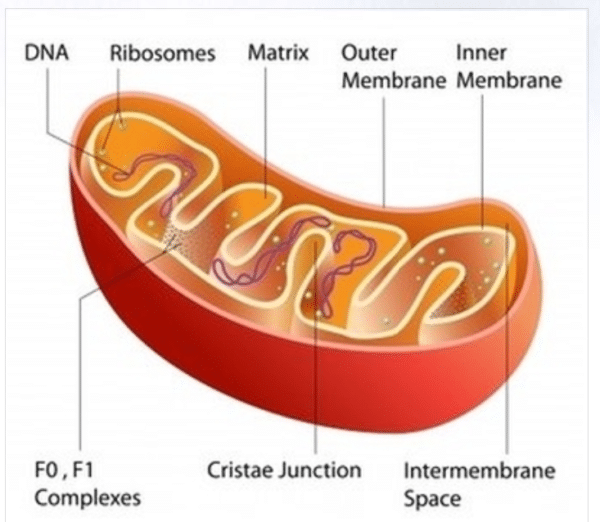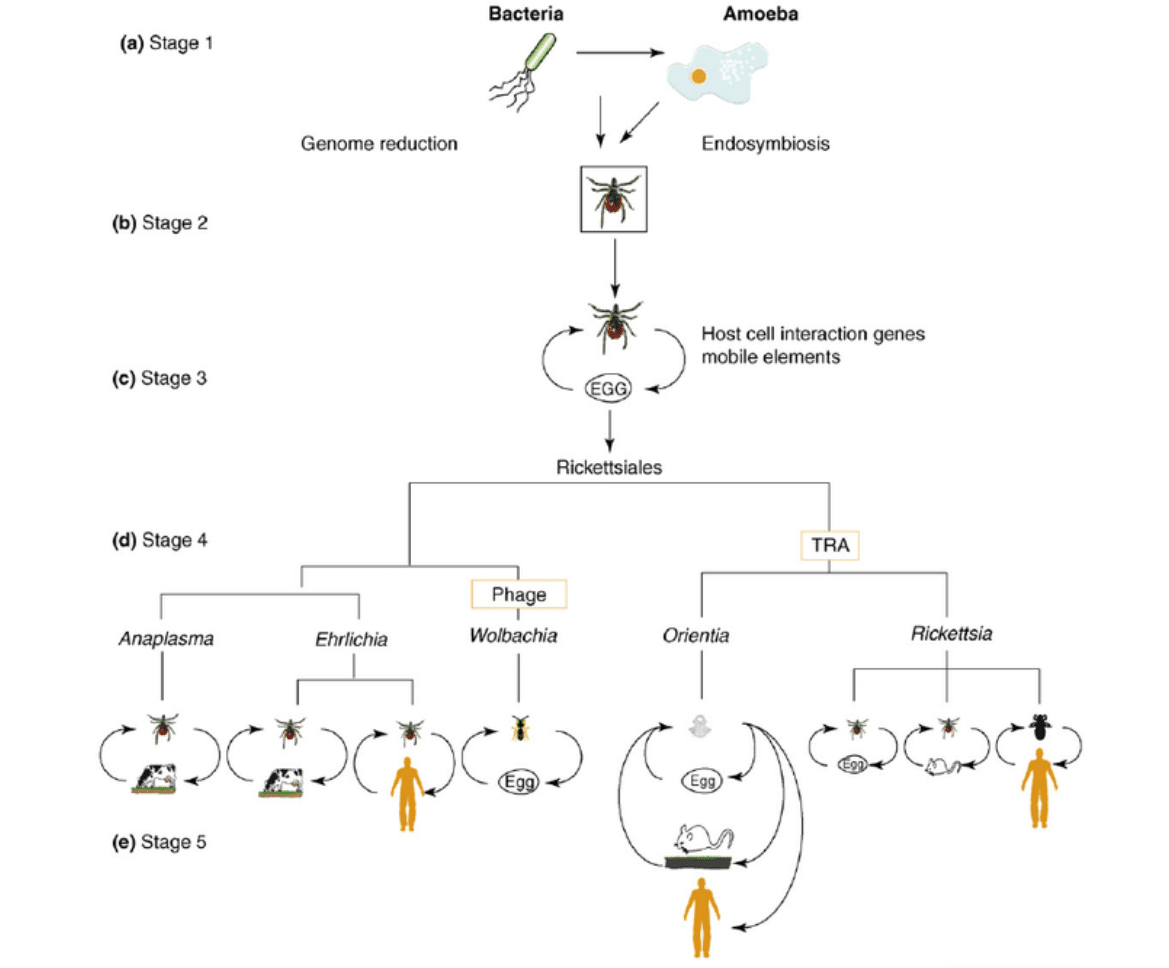We, humans, are a biological species that has survived on this planet thanks to everything that Nature has provided us. We have become so connected to this Nature that it is hard to imagine our true selves.
I will try to give a quite illustrative example with a simple bacterium, which lives inside each of us.
Every cell of ours contains hundreds to thousands of mitochondria, which are located in the cytoplasm, surrounding the cell’s nucleus. Although most of the DNA is packaged in chromosomes in the nucleus, mitochondria also have their own DNA. This genetic material is known as mitochondrial DNA. The origin of mitochondria is different from ours.

But how did this happen?
About a billion years ago, when our planet was young and regularly bombarded by meteorites, probably the last ones, a tiny extraterrestrial cell arrived. It was of the species Rickettsiales (primary mitochondria) and represented a parasitic pathogenic bacterium that took energy from every cell of the host in which it landed. And this type of bacterium, of a prokaryotic type, while interacting with other organisms, was engulfed by a bacterium of an eukaryotic type. The second bacterium adopted the “skill” of the parasitic extraterrestrial bacterium to absorb energy from every cell and thus an important bacterial evolution occurred. The same organelles of the Rickettsiales species replicated by dividing into two, using a process similar to the simple, asexual form of cell division used by bacteria. And the new eukaryotic bacteria began to replicate while copying the content of the captured extraterrestrial parasitic bacteria.

Energy has always been everything necessary for life and the most valuable resource for every living organism.
Thus, the eukaryotic bacteria that received the new skill from the prokaryotic bacterium, at some point, in their division, became modernized with another prokaryotic bacterium inside themselves and accordingly with twice as many possibilities to get more energy from food. This process of accumulating more parasitic bacteria in the cell and to this day continues, is an evolutionary competition that we have certainly carried over into the human species, in our bodies and in every cell.
And to this day, no one can make mitochondria in a laboratory, because they require both mitochondrial and genetic products from the cell nucleus.
Humanity, in its evolutionary path, has had to cope in such an unconscious way with all possible microorganisms – viruses, bacteria, fungi, and parasites. Our immune systems have evolved so high that they keep the knowledge from thousands of generations before us.

We must not underestimate Nature, and even less pretend to be her substitute.
Of course, as a species, we know a lot more about the same Nature and its endless possibilities, but we are still just babies trying to imitate her.
Now, I will tell you exactly what I mean when I comment on our attempts to imitate natural possibilities.
World scientists have long discovered the chemical elements that make up every living cell. Every plant you have seen has been thoroughly studied and described its content to the last molecule. It is easy to understand what exactly is the content of, for example, the aloe plant.
*Here we need to make a clarification that there are enough aloe species, 590 plant species and hybrids have been described in detail, and accordingly, there are sensitive differences in their chemical composition. Not every aloe is edible, nor is it used for wound treatment. There are three seriously poisonous aloe species and dozens that may not lead to a fatal outcome but are certainly toxic. The content I am commenting on is only that of the most common aloe species – Aloe Vera.
The chemical composition of aloe vera is as follows:
Aloe vera contains 75 potentially active components: vitamins, enzymes, minerals, sugars, lignin, saponins, salicylic acid and amino acids. Vitamins: Contains vitamins A (beta-carotene), C and E. It also contains vitamin B12, folic acid and choline.
You can be sure that the components of natural Aloe Vera, provided that the last is grown in non-chemically treated soil and without additional chemical treatment, will give the desired results when applied to your body. Nature has taken care of this plant in such a way that the active substance, represented in the lower formula, is far from enough to “understand” the entire plant. Moreover, the understanding that the active substance heals is very wrong.
The active substances have meaning only when they are surrounded by inactive ones, and the latter make sense of the work of the active substances. So, for a long time, vitamins were literally prescribed to every patient in large amounts, without considering whether the patient could absorb them. Only about 5-6 years ago, comments were made that vitamins (and hormones) should not be prescribed without prescribing a helper agent to facilitate their absorption. And often, the latter is not one, but several, which should be taken separately from the scheme of vitamins (and hormones).

Lately, the label “Aloe Vera extract” is popping up everywhere.
From food, drinks, cosmetics, detergents, medications, bandages, toilet paper, and whatever else you can think of.
What these products don’t tell you is that the word “extraction” doesn’t mean what most consumers think it means in practice.
No one cultivates the Aloe Vera plants needed for production, otherwise, our entire planet, in terms of area, wouldn’t be enough to produce such a large quantity of them to meet the production of all the products that proudly claim to contain them.
So, what does the word “extract” really mean?!
The answer is simple – a chemical formula of the active substance!

They’re selling it as powder, produced in chemical factories and can be “enhanced” according to the customer’s wishes in the following ways:
“Additives upon order: anthraquinones/anthrones. Aloe-emodin, aloe-chic acid, anthranol, aloin A and B (or known as barbaloin), isobarbaloin, emodin, ester of cannelic acid. Carbohydrates: pure mannan, acetylated mannan, acetylated glucomannan, gluco-galactomannan, galactan, galacto-galacturan, arabinogalactan, galacto-glucaroarabinomannan, pectin substance, xylan, cellulose; Chromones: 8-C-glucosyl-(2′-O-cinnamoyl)-7-O-methylaloediol A, 8-C-glucosyl-(S)-aloesol, 8-C-glucosyl-7-O-methyl-(S)-aloesol, 8-C-glucosyl-7-O-methyl-aloediol, 8-C-glucosyl-nor-ergeniin, isoaloe-resin D, isorhabdorin, neo-aloesin A. Enzymes. Alkaline phosphatase, amylase, carboxypeptidase, catalase, cyclooxygenase, cyclooxygenase, lipase, oxidase, phosphoenolpyruvate carboxylase, superoxide dismutase. Inorganic compounds: calcium, chlorine, chromium, iron, magnesium, manganese, potassium, phosphorus, sodium, zinc. Various, including organic compounds and lipids, Arachidonic acid, γ-linolenic acid, steroids (campsterol, cholesterol, β-sitosterol), triglycerides, triterpenoid, giberellin, lignins, potassium sorbate, salicylic acid, citric acid. Non-essential and non-essential amino acids: alanine, arginine, aspartic acid, glutamic acid, glycine, histidine, hydroxyproline, isoleucine, leucine, lysine, methionine, phenylalanine, proline, threonine, tyrosine, valine. Proteins: lectins, lectin-like substance. Sugars: mannose, glucose, L-rhamnose, aldotentose. Vitamins: B1, B2, B6, C, β-carotene, choline, folic acid, α-tocopherol. And others.“
I’m sorry to overwhelm you with so much chemistry! My goal is not to scare or deter you from using a product with “Aloe Vera extract”, but to inform you what exactly you are buying.
*To obtain a liquid “Aloe Vera extract” (gel), you’ll need to add at least 9 times more cold water to the powdered substance and mix it well.
Add comment